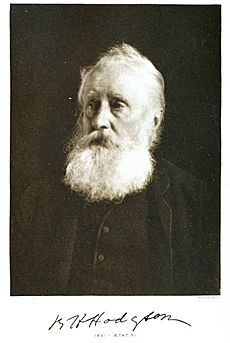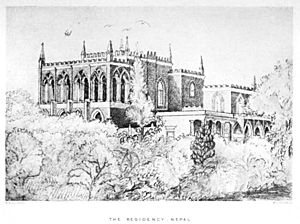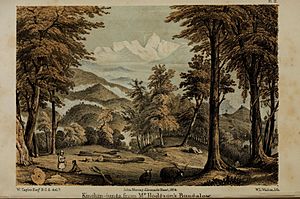Brian Houghton Hodgson facts for kids
Quick facts for kids
Brian Houghton Hodgson
|
|
|---|---|
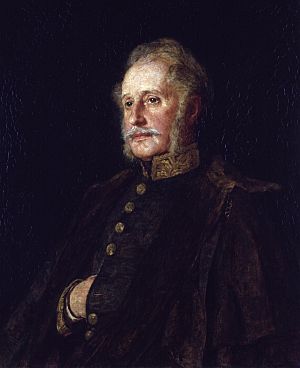
Portrait by Louisa Starr-Canziani
|
|
| Born | 1 February 1800 (but see text) Prestbury, Cheshire
|
| Died | 23 May 1894 (aged 94) London
|
Brian Houghton Hodgson (born February 1, 1800 or 1801 – died May 23, 1894) was an important naturalist and ethnologist (someone who studies different cultures). He worked in India and Nepal as a British representative. He discovered and described many types of birds and mammals from the Himalayas. Some birds were even named after him by other scientists.
Hodgson also studied Newar Buddhism and wrote a lot about languages and religions. He believed that schools in India should teach in local languages, not just English.
Contents
Early Life and Education
Brian Hodgson was born in Prestbury, Cheshire, England. He was one of seven children. His family faced financial difficulties when his father lost money. Luckily, a relative who was married to the Bishop of London helped them.
Brian went to Macclesfield Grammar School and then studied in Richmond, Surrey. He was chosen to join the British East India Company's civil service in Bengal. He went to the East India Company College where he showed a natural talent for languages. One of his teachers was Thomas Malthus, a family friend. Brian won a prize for Bengali in 1816 and graduated with a gold medal in 1817.
Working in India and Nepal
In 1818, at just 17 years old, Brian traveled to India to work for the British East India Company. His skill with languages like Sanskrit and Persian was very helpful for his job.
He first worked in the Kumaon region of India. In 1820, he became an assistant to the British representative in Nepal. However, he soon moved to Calcutta to work in the foreign office. Because of poor health, he preferred to return to the hills of Nepal. In 1824, he became a postmaster and then an assistant representative. By January 1833, he was the main British representative in Kathmandu, Nepal.
He continued to have health issues, so he changed his diet in 1837. He studied the people of Nepal and wrote many papers about their languages, literature, and religion. In 1853, he briefly visited England and the Netherlands. He married Anne Scott in the British Embassy in The Hague. She passed away in 1868. In 1870, he married Susan Townshend.
In 1838, the French government gave him an important award called Chevalier of the Légion d'Honneur.
Nepal's Politics and Hodgson's Role
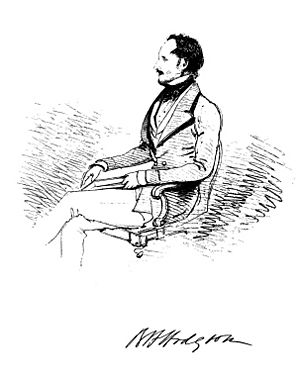
Hodgson understood that Nepal was unhappy after losing a large part of its land to the British. He thought that encouraging trade with Tibet and using local people in the British military could improve things.
He worked with different leaders in Nepal, including the minister Bhimsen Thapa and later the young King Rajendra. He tried to work directly with the King. There was a lot of political instability in Nepal, and at one point, an army mutiny even threatened the British office.
Hodgson had to use diplomacy to solve problems. He helped an Indian merchant who was sought by King Rajendra. This led to a disagreement with the King. The new main British leader in India, Lord Ellenborough, was not happy with Hodgson's actions. Ellenborough wanted Hodgson removed from Kathmandu.
Return to England and Later Life
Hodgson resigned from his position in Nepal in 1844. He then returned to England for a short time. During this period, the British leader who had wanted him removed was himself dismissed.
In 1845, Hodgson settled in Darjeeling, India, and continued his studies of the people of northern India for 13 years. Joseph Dalton Hooker, a famous botanist, visited him there. Hodgson also influenced Viscount Canning to accept help from Jung Bahadur Rana of Nepal during the Indian Rebellion of 1857.
In 1858, Hodgson returned to England and never visited India again. He lived in Gloucestershire, first in Dursley and then in Alderley.
Studying Cultures and Religions
While in Nepal, Hodgson became very good at the Nepali and Newari languages. Even though he didn't have much money until 1837, he paid a group of assistants to help him with his research.
He collected many ancient Buddhist texts in Sanskrit and Pali and studied them with his friend Pandit Amritananda. He became an expert on Hinayana philosophy, a branch of Buddhism.
Hodgson was very interested in the cultures of people living in the Himalayan regions. He believed that he could find connections between different groups of people by studying their languages. He collected rare Tibetan Buddhist works, the Kahgyur and the Stangyur, which were based on old Sanskrit writings. He gave copies of these important texts to the Asiatic Society and the Royal Asiatic Society of Great Britain and Ireland in 1838.
In 1837, Hodgson found the first Sanskrit text of the Lotus Sutra and sent it to a translator in Paris.
Ideas on Education
During his time in India, Hodgson strongly believed that education should be taught in local Indian languages. He disagreed with Lord Macaulay, who wanted English to be the main language of instruction in Indian schools. He also disagreed with those who supported using Arabic, Persian, or Sanskrit.
From 1835 to 1839, Hodgson and others wrote articles arguing for education in local languages. These essays were later published in his book, Miscellaneous Essays Relating to Indian Subjects.
Studying Animals and Nature
Hodgson studied all kinds of nature around him, including animals from Nepal, Sikkim, and Bengal. He collected a huge number of bird and mammal specimens, which he later gave to the British Museum.
Because of rules in Nepal, he couldn't travel outside Kathmandu. So, he hired local hunters to collect animals for him. He discovered a type of antelope, the Tibetan Antelope (Pantholops hodgsonii), which was named after him. He also discovered the pygmy hog, giving it the scientific name Porcula salvania, named after the Sal forest where it was found.
He discovered 39 new types of mammals and 124 new types of birds, describing 79 of the bird species himself. His collections given to the British Museum in 1843 and 1858 contained over 10,000 specimens. He also had many drawings and colored sketches of Indian animals made by local artists under his guidance. These drawings included details about the animals' bodies.
His work was recognized by many important scientific groups, including the Royal Asiatic Society and the Linnean Society in England. He became a member of the Royal Society in 1877.
Around 1837, he planned to create an illustrated book about the birds and mammals of Nepal. Many organizations supported him, and he had hundreds of people sign up to buy the book. He hoped to finish it by 1840.
After moving to Darjeeling, he became even more interested in nature. In 1849, he wrote about the geography of the Himalayas, looking at rivers, where different animals and plants lived, and the origins of the people in the region.

Many birds from the Himalayan region were first officially named by Hodgson. The International Ornithological Committee credits him with naming 29 genera (types of animals) and 77 species (specific kinds of animals).
Charles Darwin, in his book Variation of Animals and Plants under Domestication, mentioned Hodgson's success in taming young dholes, a type of Indian wild dog. Darwin also referred to Hodgson's article about different kinds of sheep and goats in the Himalayas.
Personal Life and Legacy
In 1839, Hodgson wrote that he had become a vegetarian and preferred Indian food habits due to his health. This led to him being called the "Hermit of the Himalayas."
During his time in India, Hodgson had two children, Henry and Sarah, who sadly died young. He wanted his children to have a safe life, so he sent them to live with his sister in Holland. He married Ann Scott in 1853, who passed away in 1868. In 1869, he married Susan Townshend, who outlived him. He had no children from his marriages.
Brian Hodgson passed away at his home in London on May 23, 1894, and was buried in Alderley churchyard in Gloucestershire.
Honors and Namesakes
Hodgson received an honorary degree from Oxford University in 1889. His friend Joseph Hooker named the plant genus Hodgsonia and a species of rhododendron, Rhododendron hodgsoni, after him.
Many animals are named after him, including:
- Birds: Hodgson's hawk-eagle, Hodgson's hawk-cuckoo, Hodgson's bushchat, Hodgson's redstart, Hodgson's frogmouth, and Hodgson's treecreeper.
- Other animals: Hodgson's bat, Hodgson's giant flying squirrel, Hodgson's brown-toothed shrew, and Hodgson's rat snake.
The snake species Gonyosoma hodgsoni and the plant genus Hodgsonia are also named in his honor.
|



